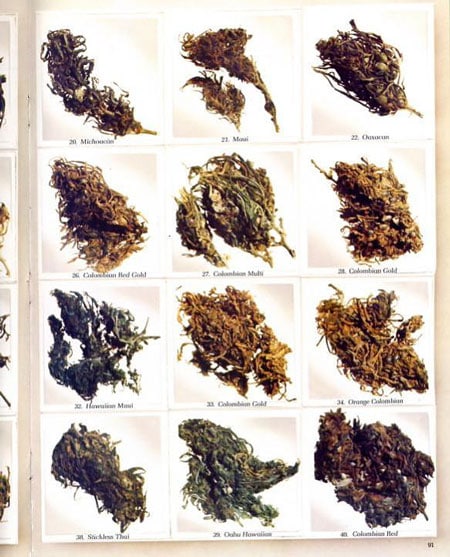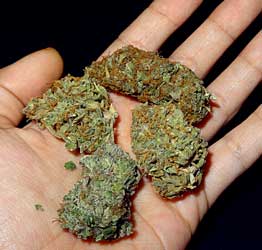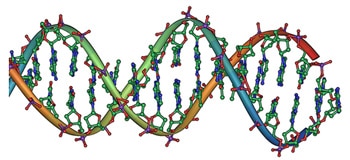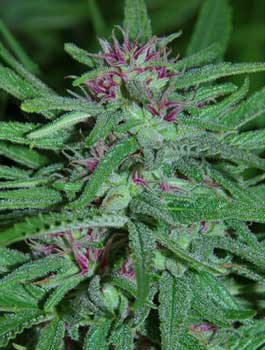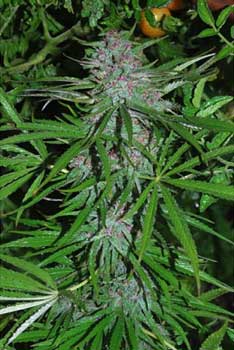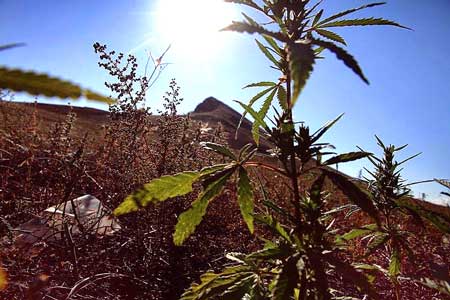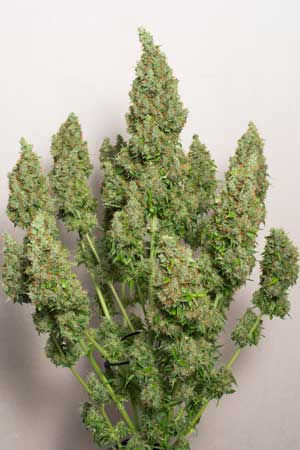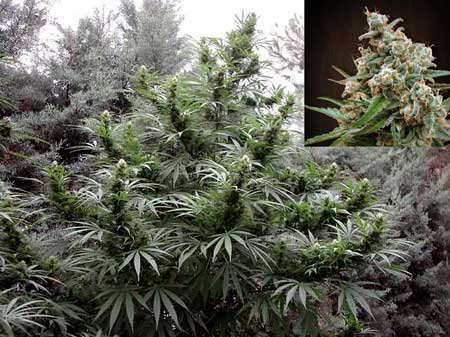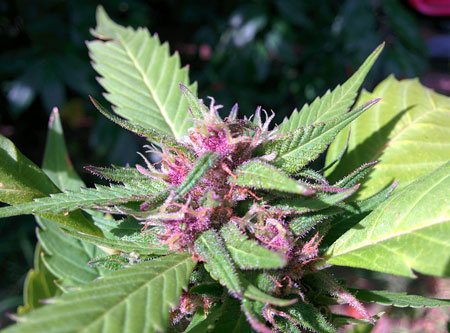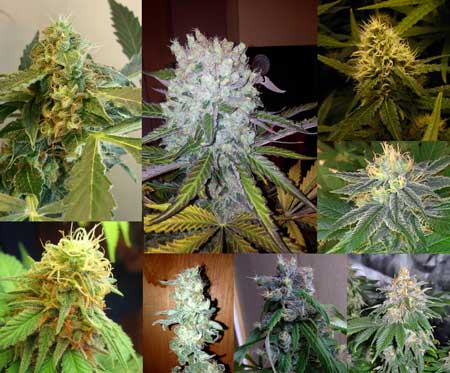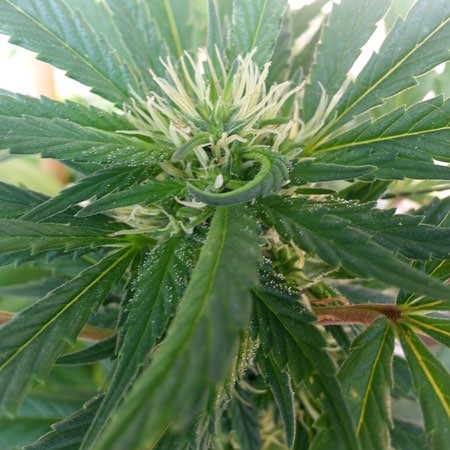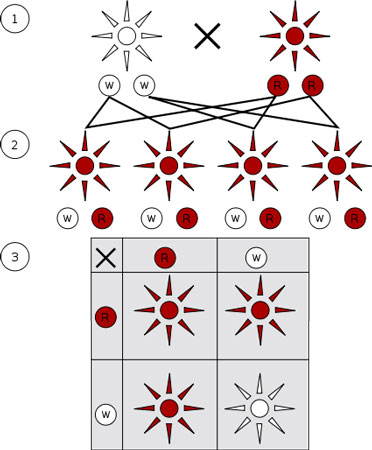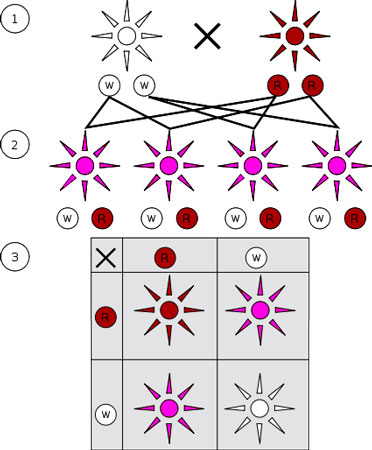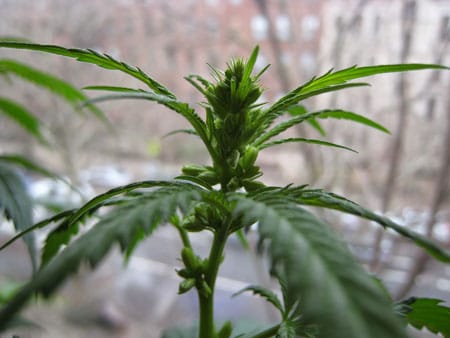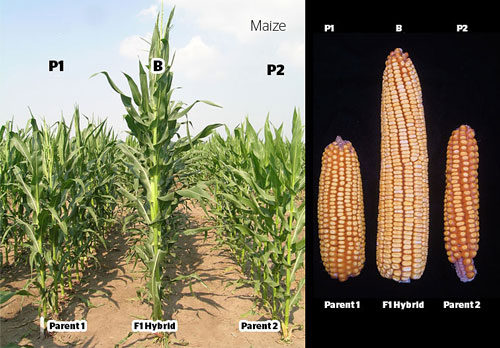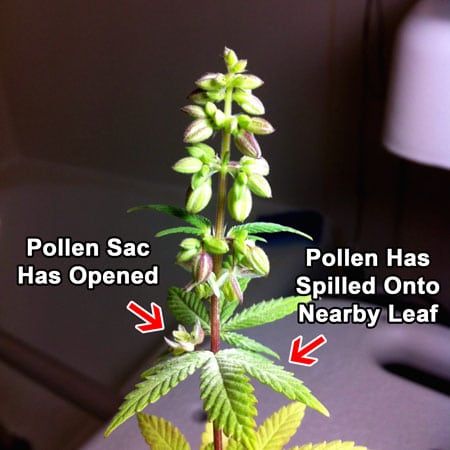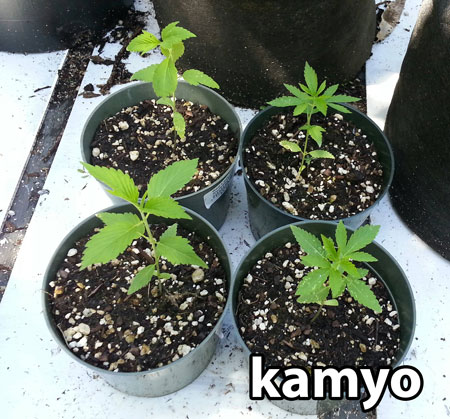by Nebula Haze
Table of Contents
- Evolution of the Cannabis Plant Through Selective Breeding
- Starting Stock: Landrace Strains
- Case Study: Development of the Ruderalis Strain
Overview: Breeding New Strains
- Phenotypes
- Dominant & Recessive Traits
- Stabilizing Strains, Back-Crossing & Inbreeding
- How to Select Male & Female Plants for Your Breeding Program
- Hybrid Vigor
Breeding New Strains – Step-by-Step
Are you interested in breeding your own cannabis strains? With all the incredible genetics available today, there are more opportunities than ever for breeding new strains.
Evolution of the Cannabis Plant Through Selective Breeding
Let’s take a look at an example of the power of selective breeding.
Here’s some of the top 40 strains according to High Times magazine in 1977
Here’s an assortment of some of today’s strains
Now some of these changes are because of different growing practices, but a lot of the changes have to do with genetics and what people have been breeding for over the last several decades.
Over the last few decades, many growers have been selecting for high-THC and “psychedelic” effects, big plump buds with big yields, shorter flowering periods, pretty colors and overall looks. Recently there’s also been many people breeding high-CBD strains for medical users.
But in addition to the percentage of THC or CBD, there’s a lot more to the overall effects of cannabis. There are many cannabinoids and terpenoids that we haven’t studied, and these all can change what effects the buds will produce. Some growers are starting to breed for other traits besides color or THC/CBD levels, paying more attention to the nuances of different strains and their effects.
For example, some cannabis enthusiasts enjoyed the cannabis they got back in the 60s or 70s, and miss certain effects from older strains. While these strains may not have been as high in THC or as “pretty” as famous strains today, they had other pleasant mental or body effects.
Luckily for breeders, many heirloom and landrace genetics have been preserved through seeds. Some seed breeders like ACE Seeds and Cannabiogen offer some interesting genetics from landrace and heirloom strains.
These days, there’s so much opportunity to grow buds that produce the exact effects you want. Growers everywhere have access to huge seed banks full of diverse genetics, both new and old.
Generations of growers before us have traveled the world finding landrace strains of cannabis, so that we all get to benefit from a huge pool of genetics for our breeding programs.
A landrace strain is a local cultivated strain; a strain which has been developed by local residents of that area.
So a grower might visit an area where the local growers have a unique strain of cannabis. Sometimes their local strain has new desirable traits you haven’t seen before (a particular color, taste, smell, potency, etc).
Many growers will take seeds to grow themselves. A landrace strain collector might bring back dozens of seed so the genetics of these local strains are preserved. These seeds are then mixed with other breeding stock to capture those traits in new plants.
Many famous cannabis breeders travel around the world to find unique landrace strains to bring into their breeding programs.
The strain Panama (shown below) is made from three heirloom strains:
Panama ’74, Green Panama & Colombian “Punto Rojo”
There are many phenotypes that show up in mixed heirloom strains like this, and unique genetics you may not be able to find in most modern strains.
Case Study: The Ruderalis Plant
A famous example a local plant that rocked growing world is the “Ruderalis” plant. People might not consider it a landrace since it doesn’t seem to be actively cultivated by local growers, but it is a local plant that’s been mixed into many breeding programs around the world.
In the wild, Ruderalis is a small, scraggly wild cannabis plant that grows in extremely cold climates with short summers. The buds aren’t potent and the plants are scrawny, but these plants had one very important trait – the ability to “auto-flower” after just a few short weeks, regardless of light schedules.
Here’s an example of two Ruderalis plants in the wild (pic taken in Russia)
this amazing pic is from the Canada CannabisClub™
Unlike most other strains, auto-flowering strains are not dependent on light schedules. Instead, they start growing buds and are ready to harvest in just a few months no matter what happens.
At some point, an enlightened grower realized that this auto-flowering trait could be useful to growers. Yet the wild Ruderalis strain would never be useful to growers in its original form, as it had low levels of THC and the buds were tiny. So breeders began crossing auto-flowering strains with quality high-potency cannabis strains.
Original crosses created relatively small plants with low potency, but growers have continued to refine and stabilize auto-flowering strains. Over the last decade or so, many breeders from around the world have been working together to isolate the auto-flowering trait in plants that produce high-potency buds and big yields. By continuously breeding the Ruderalis plants back to potent cannabis strains, we now have strains that have kept that auto-flowering characteristic, but are just as potent as modern strains (we managed to “breed out” the phenotypes that didn’t produce good buds or growth patterns).
Now there are numerous stabilized auto-flowering strains that are just as potent and beautiful as any other strains, and several breeders now also carry an auto-flowering version of their regular strains.
Here’s an example of a modern auto-flowering plant (Dutch Passion AutoMazar ↗) about 2.5 months from seed. This pic is just after harvest and the plant ended up producing about 4 ounces of high-quality bud.
It doesn’t look anything like it’s wild cousin anymore, does it? And the potency and effects of high-quality modern auto-flowering strains are now about the same as photoperiod strains.
In just a few years, breeders were able to take a scraggly hemp plant and breed out everything except the auto-flowering trait. This gave breederd the power to create potent auto-flowering strains around the world.
As a breeder, you have the power to identify specific traits and then incorporate them into your strains, leaving behind everything you don’t want.
Overview: Breeding New Cannabis Strains
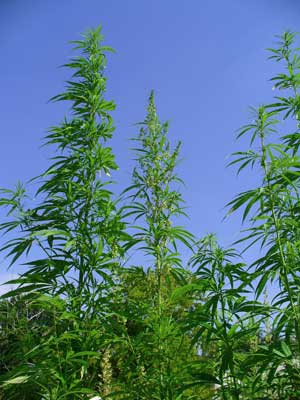
Just like many strains now have different effects than popular strains from years ago, you could create strains that are better for you than anything available today. You can even take older heirloom strains and create unique strains that no one has ever experienced.
Every plant is a little different, and when someone grows a seed, the resulting seedlings will have a mix of traits from each of their parent plants. As different plants are bred together, people can select to cross only their favorite plants. They can create new combinations that produce unique and wonderful effects.
Over a few generations of picking the most desirable plants for breeding, new seedlings will show more of the specific traits you’ve selected for, and less of the traits you’ve selected against.
This is basically how new strains are born, though there are several special techniques (explained below) to help you get to your goals as quickly and efficiently as possible.
Traits to possibly select for when breeding
One of the first things to consider is “what am I trying to achieve by breeding?” There’s millions of breeding combinations that could produce all kinds of crazy buds, but each breeder has different goals.
Growth Patterns – does the plant grow tall or short, long & lanky, short & bushy, how long until harvest (length of flowering stage), yields, etc
Hardiness – how fast plants tend to grow, resistance to mold or root problems, whether it can stand heat or cold, how strong the stems are, etc
Buds – Smell, Color, Appearance, Perceived Effects, Potency, THC or CBD levels, etc
The bigger your pool of genetics (the more plants you have to choose from), the easier it becomes to find specific traits that you want to include in your breeding program.
For breeders, it’s exciting to live in a time when there is an abundance of genetics available to anyone with a mailing address, whether you want to try the new popular strains or find an old heirloom strain to create something new.
This is Nepal Jam, a strain carrying heirloom genetics; it was made from a cross between a Nepalese Highland sativa x Jamaica ’85 strain
Unfortunately most breeders can’t grow dozens or hundreds of plants at a time, so it’s helpful if you have other growers willing to grow your seeds out and let you know how the plants turn out.
As growers breed together plants of known strains, they are able to develop new and interesting strains that carry the best traits from the parents. As time goes on, this process of artificial selection creates plants that look nothing like their ancestors.
Growth Patterns & Hardiness
Figuring out the hardiness and vegetative growth patterns of a plant is relatively easy. You simply need to observe plants while they’re growing.
But some traits are much more difficult to stabilize than others, especially when it comes to the buds themselves.
Unfortunately, the more you focus on one particular trait, the less you can pay attention to other traits. Color is a great example of a trait that’s somewhat difficult to breed for because of this reason.
Color
Colored strains are very popular these days. Purple and pink buds are especially popular, but when it comes to color of buds, it’s difficult to stabilize a strain so that 100% of offspring are the same color as desired.
One problem with trying to stabilize a color, is it can cause breeders to pay less attention to how the plant grows, how buds smell, and what the effects will be.
That’s why it’s important to pay attention to all traits in a breeding program! Don’t only pay attention to color.
In order to preserve the other desired effects (potency, smell, etc), growers may sometimes include genetics that don’t produce colored buds. As a result, many colored strains that you get today will have some plants that produce color, while other plants of the same strain will make buds that grow green. Some strains are stabilized to almost always produce color, but sometimes these strains are lacking in other ways because the breeder paid more attention to color than effects.
When it comes to color, it’s important to understand that the color of buds doesn’t have anything to do with cannabis potency. It’s simply a visible trait, just like how many flowers come in different colors. Purple cannabis buds can be ultra-potent, or they can be “meh.” The effects produced have to do with the breeding/genetics and growing style, not the color.
Smell

And to make things more confusing, every cannabis bud produces a bouquet of many different smells. Because of this complexity, it can be difficult to “lock in” a certain smell in a strain, especially smells that are recessive traits. Without any way to actually “measure” the smell, you have to rely more on your personal feelings and gut instinct.
It can several generations of trying different crosses and seeing the results before growers are able to produce plants that tend to smell like something new.
Yet we’ve got strains that people agree smell like pineapple, blueberry, strawberry, bubble gum, sandlewood and more. It’s definitely possible to breed cannabis strains that produce unique new smells that add to the whole cannabis experience.
Potency
Some growers test for THC and CBD levels, and these can be very important traits for medical cannabis patients.
But in addition to THC and CBD, there’s a lot of other aspects that contribute to the perceived potency and effects a strain will have on you. There are dozens of cannabinoids that we haven’t studied (and therefore don’t test for); there’s also terpenoids and other bud factors that likely affect the experience from using cannabis. Because of this, there’s no one factor that all growers should be paying attention to. What’s most important is creating a strain that you like.
When it comes to selecting for potency, I recommend choosing to breed the plants that produce the mental and physical effects you like. If you’re only breeding plants that you like, the potency will take care of itself and you’ll end up with better and better buds over time.
You don’t necessarily need to know the THC and CBD levels to know what you like 🙂
Phenotype = Genetics + Environment
A “phenotype” is simply a list of all the various traits that you observe in a plant (how a plant grows, how the buds turn out, etc). You’ll likely hear this word a lot when talking about breeding cannabis strains.
People might talk about how a strain has a “tall” or “short” phenotype, or perhaps that some of the plants display a “pink” phenotype that grows pink buds.
Phenotypes are like the traits children get from their parents. Each child is a different phenotype. So YOU are a phenotype made from your parents, and each of your siblings (if you have any) would be a different phenotype.
Imagine two parents; one is very tall and the other is very short. Each of their children could be tall or short. But if both parents and everyone in their family are tall, chances are their children will be tall too.
This is similar to how phenotypes work with plants.
Here’s a small sample of some ways cannabis buds can form – each displays a different phenotype
Here’s an example of two plants with completely different growth patterns in the flowering stage. Each of these plants displays a different phenotype in this environment due to the differences in their genetics.
“Unstabilized” strains carry more than one common phenotype (sometimes many). What that means is you can get two plants of the same strain, but they can display different phenotypes (they may look and grow completely differently from each other).
Some strains are more “stabilized” which means that all the seeds of that strain display the same phenotype. All plants grow the same way. This stabilization is accomplished by careful breeding to ensure that all seeds only carry genes for the desired phenotype.
But genetics isn’t the only thing that affects how your plants grow. Both the plant’s genes and the environment influence the phenotype that you see.
In fact, the environment plays a really big role in how your plants turn out.
Let’s say you take a clone of a plant (an exact genetic copy of the original). These plants will grow similarly in the same environment, but they often grow very differently in different growing environments.
For example if one environment tends to be cold, it might slow down the plant or even kill it, but that same plant might thrive in a warmer temperature. Some plants might do well with lower levels of nutrients, but have all kinds of problems with higher levels of nutrients. It depends on the genetics the plant inherited from its parents. A good breeder will know the environment their strain tends to perform best, and can help you understand how to get the most from each strain.
From now on, I’m just going to talk about specific traits that help make up the phenotype of a plant, since these are what most breeders are paying attention to.
Some traits are “dominant” and some are “recessive”. This means that your plants can sometimes be carrying “hidden” traits which won’t show up unless you breed together two plants that both carry a copy of the hidden gene.
So for example, you could take two plants that grow green buds, but some of their offspring could produce pink buds. This means that the parents were carrying genes that can make pink buds and this recessive “pink” trait was brought out in their offspring.
Ultra-Quick Rundown of Mendelian Genetics & Inheritance
Knowing a little bit about genetics and inheritance will give you a huge advantage in your breeding program.
The first thing you need to know is that all plants (and animals) get two version of each gene, one from each of their parents. The interaction between the two versions of a gene can have a huge effect on your plant.
Mendelian genetics examines how plants and animals show different phenotypes depending on their genes.
So lets start by looking at dominant and recessive genes. Certain genes have complete dominance, which means they always “take over” if the plant has even one copy of the gene. Recessive genes will only show up in the phenotype if the plant got two copies of the same recessive gene from each of its parents.
The figures below show examples of Mendelian inheritance. This is super-simplified, but could help you get a better understanding of dominant and recessive genes.
Complete Dominance – Let’s say that cannabis plants can have a “red” or “white” version of a gene that controls bud color. The red version is completely dominant, and the white version is recessive. That means that (with these genes) the plant can only shows buds that are either red or white. It doesn’t “mix” them.
Let me give you an example with a diagram. “R” is the dominant gene in the diagram below. What that means is if a plant carries any copy of the “R” (red) gene than the buds will be red. The buds will only be white if the plant gets two copies of the “W” (white) gene. Let’s look at what happens over 3 generations if a plant with two “R” genes is bred with a plant that has two “W” genes.
Mendelian Inheritance Example – Complete Dominance
(1) Parent generation
(2) F1 generation
(3) F2 generation
You can see that the first generation (F1) above would produce only red flowers since all the offspring would get at least one copy of the “R” gene. But if you crossed those F1 plants together, you would get about 3 reds to every 1 white since you’d start getting plants that received two copies of the “W” gene.
But in many cases, genetics are not that simple. Not all genes follow the dominant-recessive pattern. Often it’s not a case of genes being only “on” or “off.” They may interact with each other to form new combinations. And to add to the confusion, certain traits are produced by the interaction of dozens or even hundreds of genes.
Incomplete Dominance – Let’s look at an example where the genes have incomplete dominance over each other. In these cases neither version of a gene is “dominant.” Instead they partially affect each other.
So what does that look like in practice? The next diagram shows an example of incomplete dominance.
Just like the above example, we start with two plants, one with two version of “R” (buds turn red), and the other with two “W” genes (buds turn white).
But this time both genes display “incomplete” dominance – it’s not that the offspring will show just one version or the other, but actually a mix of the two.
This time, when a plant gets one copy of “R” and one copy of “W,” the flowers will actually turn pink.
Neither version of the gene is completely dominant, so they influence each other creating a “mix” of the two versions of the gene.
Mendelian Inheritance Example – Incomplete Dominance
(1) Parent generation
(2) F1 generation
(3) F2 generation
In this case, the first generation above would produce only pink flowers since all offspring would get one version of each gene. But if you crossed those F1 plants together, you would get a 25% chance of getting white or red, and a 50% chance of getting pink flowers.
But so much more can be affected by genes than just the color of cannabis buds. Smell, taste, mental effects and more are all affected greatly by the genetics of a plant.
One of the best ways to discover interesting hidden or recessive genes in your gene pool is to first cross your starting plants, and then cross their offspring together or “backcross” with their parents to see if new traits appear.
Once you’ve identified a trait you’d like to keep, then you can start crossing that plant with other members of its “family” until you’ve figured out which plants you need to breed together for their offspring to always show that particular trait.
Over time, growers can develop a whole “suite” of new traits that can be consistently bred from their genetic stock.
You may enjoy learning more about genetic inheritance. A great tool to help you visualize dominant and recessive traits is the Punnett Square (shown above) to help you predict how a particular plant cross might turn out. There are other inheritance factors, such as non-medelian inheritance and epigenetics, that can also affect how your plants grow.
Stabilizing Strains, Back-Crossing & Inbreeding
A stabilized strain produces consistent results from all its seeds. To accomplish this, you must manipulate your genetic stock via breeding and back-crossing until you get a set of parents that consistently produce offspring that all grow the same – almost like being able to deliver clones in seed form. With a stabilized strain, growers know exactly what to expect when growing a strain since all seeds grow the same way.
“Back-crossing” is a powerful technique to help breeders stabilize strains. Back-crossing is when you take a plant or animal and cross it with one of its parents (or possibly another closely related family member). The idea is to create offspring which are genetically similar to the desired parent. Each offspring from a backcross is more likely to carry two versions of the desired parent’s genes.
So for example, let’s say you cross two cannabis plants. The mother plant has a trait you like (like a great body “stone”). You can take the male plants from her offspring and cross them back with the mother plant. This gives you offspring that are more like the mother (have more versions of her genes), and therefore are more likely to pass the trait (great body “stone”) to the next generation.
Some growers refer to the back-crossing process as “BC” or “BX” (B = back and X = cross).
As a result of back-crossing, you can “lock in” desirable traits from a specific plant so the strain consistently produces plants that grow the way you want.
Heavy back-crossing causes heavily inbred plants. This can sometimes result in bad recessive genes getting locked in (if a plant gets two versions of a “bad” gene, than it will suffer since it doesn’t have a “better” version of the gene to fall back on). This is how inbreeding can go wrong.
Inbreeding can also result in healthy uniform plants which tend to produce consistent offspring. The “good” type of inbred plant is an asset to breeding programs because you can easily predict some of the traits that will be passed on to the next generation. Heavily inbred plants carry two identical versions of many of their genes, and therefore will consistently pass only their particular version of each gene to all their offspring. If a plant has two identical versions of the “W” gene, for example, than that means all their children will get at least one version of the same “W” gene. This can be used to predict traits in the offspring before you even cross your plants.
When to backcross? If you like how a particular plant grows, that’s when you backcross. You’re trying to “lock in” certain traits into your genetic pool. By backcrossing, the offspring become more like the parent, and more likely to pass those traits on to the next generation.
Unless you plan on creating heavily inbred plants, you generally only need to backcross once or twice to get the genetic stability needed to start developing a new strain.
Excited yet? Let’s talk about your own breeding program.
How to Select Male & Female Plants for a Breeding Program
Female Plants – It’s relatively easy to select for female plants in a cannabis breeding program. You simply grow the female plants out and wait for the results. If the plant grows well and buds are good, keep it! If you didn’t like how this particular female plant turned out, trash it!
Note: Some growers will take a great female plant and cross it with itself via feminization to back-cross the single plant more effectively and quickly than by using its offspring. Some growers will also cross two different female plants, skipping the process of finding males altogether. Some growers are against using feminization as part of the selection process of a breeding program. These growers believe that by forcing female plants to make pollen sacs for feminization, you may be unintentionally selecting for hermies (plants that show both male and female plants). The jury is still out on what’s best, though many breeders have strong feelings either way. Most growers seem to agree that male plants are an important part of every long-term breeding program.
…But it’s a lot tougher to know what genes are carried by male plants since they don’t produce buds. You can’t know what “bud traits” a male plant will produce until you start breeding it with several different female plants and look at the offspring.
Through the slow process of breeding males and looking at the offspring, breeders can identify particular male plants that are great at producing certain traits in their female offspring.
Male Plants – Proven male plants are probably some of the most prized and important parts of any cannabis breeding program. The reason is that male plants are “silent carriers” for the genes that produce buds. The only way to know for sure what traits a male plant will pass onto female offspring is to breed it with different known female plants and see how the offspring turn out. After a lot of testing, a grower can create or find a male plant that is known to give desirable traits to its offspring.
For example, you could find a male plant that tends to make offspring whose buds smell like blackberries. Even though the male plant never grows buds at all, it is silently carrying the bud trait of smelling like blackberries. This type of knowledge can be extremely useful if you’re trying to cross a male with your female plants.
The process of picking males for a breeding program is time-consuming and you’ll need to keep great notes about each offspring of a male plant in order to learn what silent traits the male plant is carrying for its female offspring.
Harness the Power of Hybrid Vigor (Heterosis) & “F1” Crosses
When you take two unrelated, heavily inbred plants and breed them together, you end up with something known as “heterosis” in the offspring.
Heterosis happens when breeding two plants that are…
Heavily inbred (gone thorough several generations of back-crossing and/or breeding between closely related plants)
Unrelated to each other (they don’t share any known ancestors)
Heterosis can sometimes be used to increase yields, uniformity, and vigor of the plants. When this happens, the result is known as “hybrid vigor.” Offspring from the same parents with hybrid vigor tend to grow the same as each other; plus they can grow faster, be stronger, and/or produce bigger yields than either of their parents.
This effect will only happen for the first generation (“F1”) cross between the two inbred plants. If you breed F1 crosses together, they will no longer experience hybrid vigor. It only happens with the first cross between two heavily inbred plants.
Sometimes an F1 cross between two unrelated inbred plants can produce undesirable or surprising results, but growers are often rewarded with better vigor and uniformity from F1 crosses.
You can use hybrid vigor to your advantage once you’ve identified a great F1 cross. If two parent plants create an awesome F1 cross, some growers will keep the “mother” and “father” plant so they can use them repeatedly to breed and make more seeds of the same F1 cross. This ensures that all the offspring get to benefit from hybrid vigor, plus they’ll all grow the same as each other. Some “strains” are actually a specific F1 cross between two parents that produces a desirable result every time.
For example, the strain “Aurora Indica” (↗) is actually an F1 cross between a specific Afghan x Northern Light plant. These same two plants are bred over and over again to make more Aurora Indica seeds. As an F1 cross, all Aurora Indica plants get to benefit from hybrid vigor.
The “hybrid vigor” technique is used in many types of plant cultivation, not just for growing cannabis. A familiar example is with corn. Most of the corn people eat today is an F1 cross. Since the 1940s, many of the most popular “strains” of corn are actually the first-generation hybrids made from inbred strains. Each F1 cross has been chosen because it produces specific traits, for example yield, appearance and hardiness. The F1 attribute helps ensure that all the resulting corn looks/tastes the same, and is ready to harvest at the same time.
Photo credit: b4faa.org original link
The growers of corn have found a great F1 cross that produces better results than any individual strain on the market. Notice how the F1 offspring seems to be better than its parents in almost every measurable way. By crossing the same two “parents” every time, corn breeders know that every one of the F1 offspring will perform the same way, get similar yields, and be ready to harvest at the same time. That’s the power of hybrid vigor!
Are you ready to start searching for your own perfect F1 cannabis cross?
Breeding New Cannabis Strains – Step-By-Step
Important! Always label every plant or clone! It’s surprisingly easy to lose track of which plant is which, especially if you are working with a lot of plants
Choose Your Male & Female Plants – whether you’re backcrossing, creating an F1 hybrid, or just crossing two great plants together, you need to first decide which two plants will become your “parent” plants. The rest of this article should help give you ideas on how to choose the best parent plants for your goals.
Separate Males & Females – After you’ve decided which plants you want to breed together, keep males separate from females throughout the grow process (or remove males at beginning of the flowering stage). No matter what, make sure males are separated from females as soon as male pre-flowers (small pollen sacs) appear. Make sure that no pollen from the male makes it to the females without you doing it yourself, or you will end up with seedy buds of unknown genetics.
Collect Pollen from Males – Wait until pollen sacs are well-developed before collecting pollen from the desired male plant.
• Not sure when to collect pollen? This picture will show you what mature pollen sacs look like, as well as what the pollen will look like.
• You can take a ziplock bag, place it around the stem and shake to get the plant to release pollen into the bag. If you can’t use it right away, save any pollen in a sealed ziploc bag in the freezer. Fresher pollen is better, and many growers recommend throwing pollen away after a month.
• Some growers save their prized males as “father” plants, taking clones to flower and make pollen on demand when needed (instead of storing pollen in the freezer).
Pollinate Females – Female cannabis plants are ready to be pollinated a few weeks after they first show signs of white pistils. At this point there will be individual buds forming, but the hairs/pistils will still be white. It’s important to avoid pollinating the wrong plant, so before you start, isolate the female plant from other plants and turn off any fans. Take the ziplock bag full of pollen and gently place over a stem with several buds forming. Seal it at the base so no pollen can get out. Carefully rotate and shake the bag to cover buds with pollen. Leave bag on for an hour or two, then carefully rotate and shake bag again. Wait two more hours then carefully remove the bag.
Care for “Pregnant” Mother Plants – Make sure to provide mother plants with a good source of nutrients, including more nitrogen than what’s included in most “bloom” nutrient formulas. It may be helpful to switch to a “vegetative” nutrient schedule to make sure seeds get what they need during the seed formation process. Seeds should start forming a few weeks after pollination, and will be busting out of their heavy calyxes several weeks after that. If you need to keep the seeds for a while, save them in a cool dark place (but don’t freeze them).
Plant Seeds – Germinate your seeds and see how they grow. Do they grow fast or slow? How do the buds develop? How long is the flowering stage? Smell? Taste? Potency? It may be helpful to keep clones of all your plants just in case one of them happens to be a real winner. That way you can use it as part of your breeding program indefinitely.
Keep Records! To breed successfully, one of the most important things is to keep great records. Write down which plants were bred together and how their offspring turned out. This lets you keep track of traits that show up in the parents and offspring. This will also help you create new strains because you’ll be able to know what traits to expect when breeding certain plants.
“Making stable hybrids relies on the ability to test-grow as many offspring as possible in each new generation, in order to assess how desired qualities are passed on and decide whether a strain is ready or needs more fine-tuning.”
~Sensi Seeds
To help keep track of what genetics are contained in each plant, many breeders have several growers testing out their strains and crosses. This helps provide valuable information about what phenotypes are showing up for particular crosses. It’s difficult for most breeders to grow and study hundreds of plants in different environments, so having people to grow out your strains and report back gives valuable information for your breeding program.
No matter how you choose to do it, always be testing your plants and getting feedback from other growers! This helps alert you to any negative phenotypes that must be “bred out”. For example if certain plants produce offspring that don’t smell/taste/give effects the way you want, you’ll know that the parent plants carry a phenotype that should be bred out of the gene pool so that no growers unexpectedly get those traits.
On the flip side, you might learn about wonderful new traits that you didn’t realize were there in the genetics of your parent plants.
Most importantly, breed plants you like! 🙂
You are now armed with the information you need to create your breeding program and develop your own strains! You could be the next famous breeder and cannabis cup winner!
Bonus! Neat example showing recessive traits.
From source kamyo: “This is a cross consisting of Ducksfoot/AfghanErdpurt x Ducksfoot/Pakistani Chitral Kush. The webbed leaf trait of ducksfoot is recessive and will rarely show in F1 hybrids of ducksfoot/non-webbed plants. In this case, two F1 hybrids were crossed, and it was estimated that maybe 25% would show webbed traits. That estimate seems pretty accurate, but it might even be more than that. Just thought it was worth showing different phenotypes that can show from the same parents.”
Jump to…
Enhance the smell of your buds
Terpenes & Terpenoids: The real cause of smelly, stinky cannabis
7 Tips to Growing Top-Shelf Buds
Plant Training – Topping & More!

